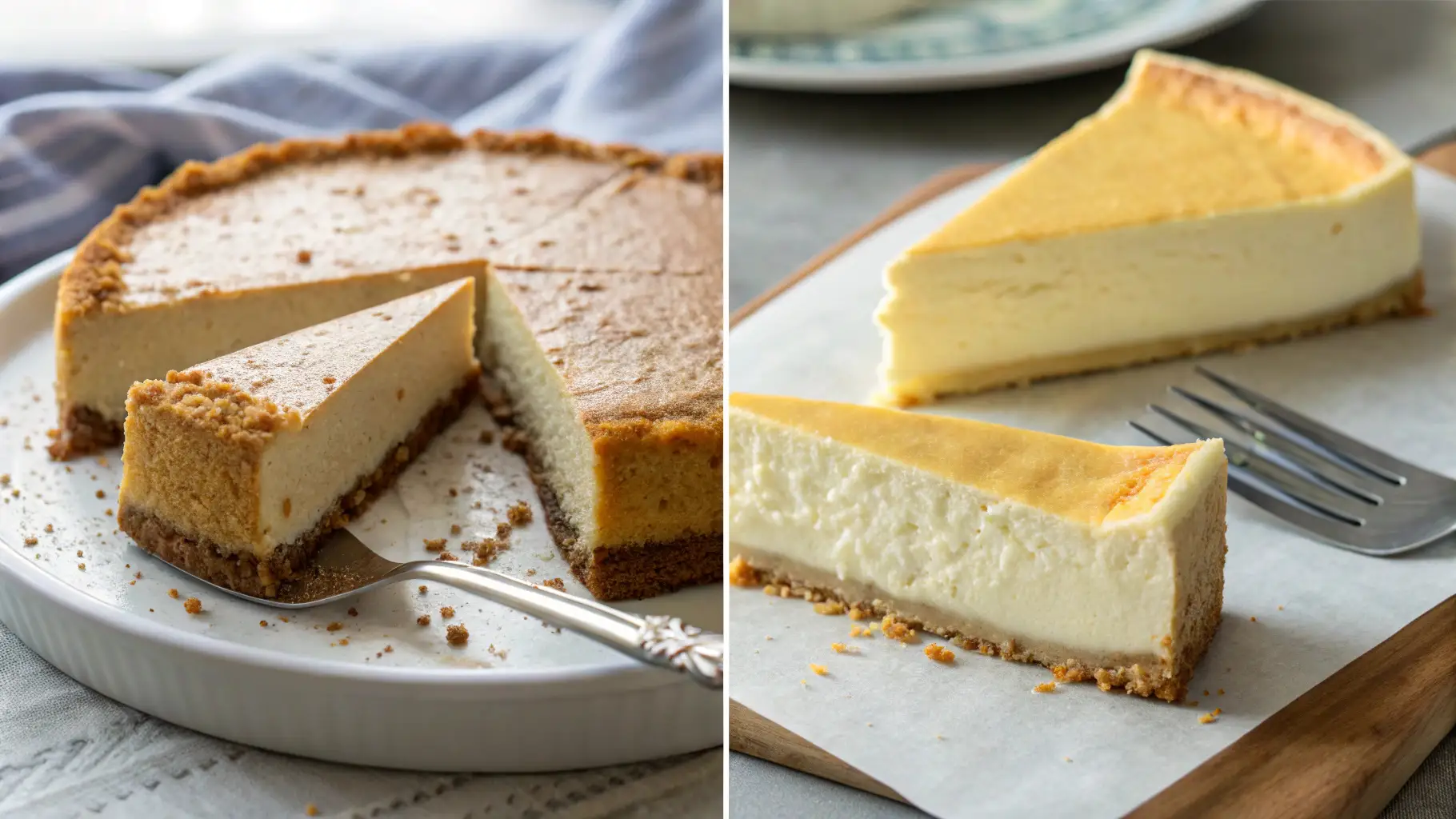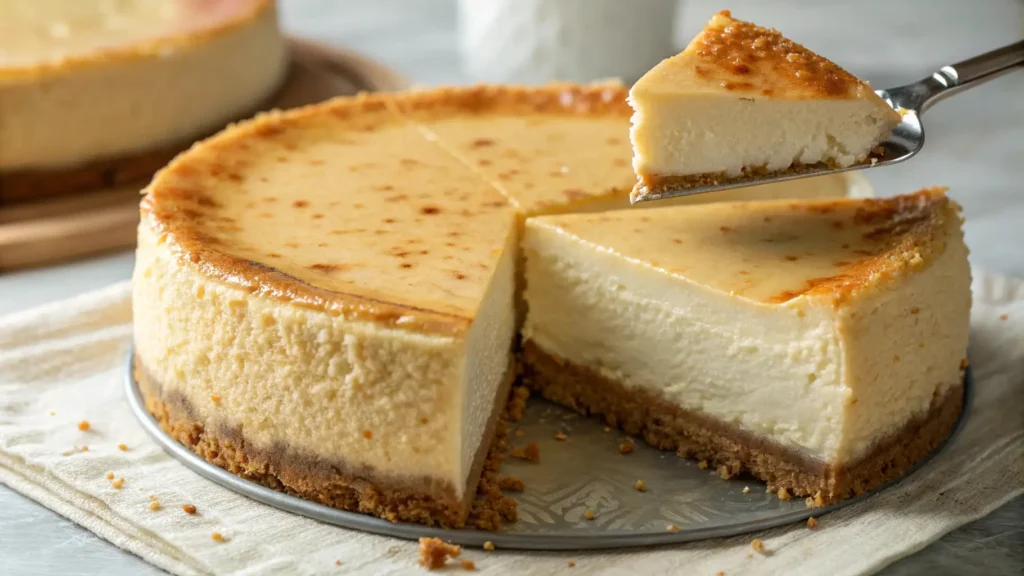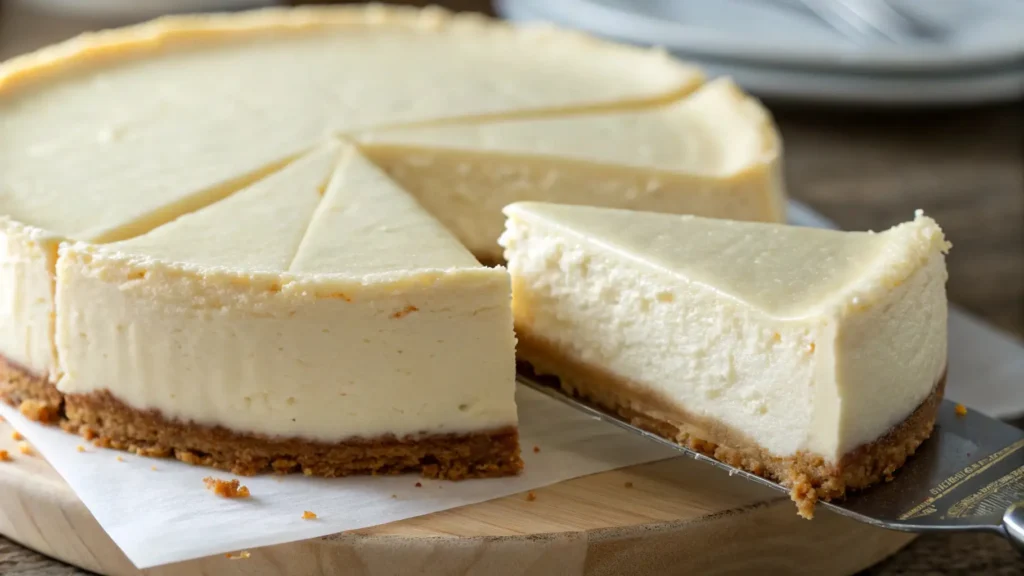Cheesecake is one of the most beloved desserts in the world, offering a perfect balance of creamy texture and rich flavor. While it comes in many varieties, two main types stand out: baked cheesecake and set cheesecake. Each has its own unique preparation method, texture, and flavor profile, making them suitable for different occasions and preferences.

But what exactly is the difference between baked and set cheesecakes? In this article, we’ll explore their defining characteristics, compare the two, and provide tips for choosing or preparing the perfect cheesecake for your next dessert adventure.
What Is a Baked Cheesecake?
Baked cheesecake is the traditional style of cheesecake that is prepared by mixing a cream cheese-based batter and baking it in the oven. This method gives baked cheesecake its distinctive rich texture and flavor.
1. Preparation Method
- Ingredients: The batter is typically made with cream cheese, sugar, eggs, sour cream, and flavorings like vanilla or lemon. Some variations may include heavy cream for extra richness or a touch of cornstarch for added stability.
- Crust: Often features a base made of crushed graham crackers, digestive biscuits, or cookie crumbs mixed with butter. Some variations use crushed Oreos or nuts for a unique twist.
- Baking: Unlike no-bake versions, baked cheesecake is cooked in the oven at a low temperature. Many recipes recommend using a water bath (bain-marie) to ensure even cooking and prevent cracks from forming on the surface. The slow baking process helps develop its signature creamy texture.
2. Texture and Flavor
- Texture: Baked cheesecake is creamy, dense, and smooth with a custard-like consistency. The eggs in the batter help it set firmly, giving it a rich yet delicate bite.
- Flavor: The baking process enhances the depth of flavor, resulting in a rich and slightly tangy taste. The caramelization that occurs during baking can also add a subtle, toasty note to the crust and edges.
💡 Pro Tip: Allow baked cheesecake to cool gradually in the oven with the door slightly open before chilling. This prevents cracks and helps maintain its silky texture.
3. Common Variations
- New York-Style Cheesecake: Known for its dense, ultra-creamy texture with a slightly tangy taste, often made with extra cream cheese and baked without sour cream. It has a thick, smooth consistency and is usually served plain or with a light fruit topping.
- Ricotta Cheesecake: A variation made with ricotta cheese instead of cream cheese, resulting in a lighter, slightly grainy texture. This type is popular in Italian desserts and offers a more delicate, subtly sweet flavor.
- Chocolate or Fruit Swirl Cheesecakes: These variations incorporate additional flavors by swirling in melted chocolate, fruit purées, or caramel before baking. The swirls create a marbled effect, adding both visual appeal and bursts of flavor in every bite.
- Basque Cheesecake: A crustless, caramelized version that is baked at a high temperature to create a deep golden-brown exterior with a creamy, almost molten center.
What Is a Set Cheesecake?
Set cheesecake, often referred to as no-bake cheesecake, skips the oven entirely and firms up in the refrigerator instead. This method creates a lighter, silkier, and softer dessert that requires minimal effort while still delivering a deliciously creamy texture.
Unlike traditional baked cheesecakes, which rely on eggs and baking to set, set cheesecake uses chilling to achieve its smooth consistency. It’s a perfect choice for those who want a fuss-free, easy-to-make dessert without needing to turn on the oven.
1. Preparation Method
- Ingredients: The batter is made using a blend of cream cheese, sugar, and either whipped cream or condensed milk to create a creamy, stable consistency. Many recipes include gelatin or agar-agar to help the filling set more firmly, ensuring the cheesecake holds its shape when sliced.
- Crust: Just like a baked cheesecake, set cheesecakes typically have a crushed graham cracker, cookie, or biscuit base mixed with melted butter. This provides a crunchy contrast to the smooth filling.
- Chilling: The cheesecake is refrigerated for at least 4–6 hours, but for best results, chilling overnight allows it to fully set and develop a firmer texture. Unlike baked cheesecakes, which need time to cool before serving, set cheesecakes are ready to enjoy straight from the fridge.
💡 Pro Tip: For the best consistency, let the cheesecake sit at room temperature for 5–10 minutes before slicing, ensuring clean and smooth cuts.
2. Texture and Flavor
- Texture: No-bake cheesecake has a light, airy, and mousse-like consistency, making it much softer than its baked counterpart. The absence of eggs gives it a silky, smooth mouthfeel without the density of a traditional baked cheesecake.
- Flavor: Because it doesn’t go through the baking process, the flavors remain fresh and bright. It’s generally less rich than baked cheesecake, offering a delicate, creamy taste that pairs well with various toppings and mix-ins.
💡 Pro Tip: Add vanilla extract or citrus zest to the filling for extra depth of flavor without overpowering the cheesecake’s natural creaminess.
3. Common Variations
One of the best things about set cheesecake is its versatility. It can be easily customized with different flavors, toppings, and mix-ins to suit any preference. Here are a few popular variations:
- Lemon Cheesecake: Bright, tangy, and refreshing, with added citrus juice or zest to enhance its zesty flavor.
- Chocolate Cheesecake: A rich and indulgent twist that incorporates melted chocolate or cocoa powder into the batter for a decadent chocolate flavor.
- Fruit-Topped Cheesecake: Often served with fresh fruits or fruit sauces such as strawberry, raspberry, or blueberry for a refreshing and slightly tart contrast.
- Oreo Cheesecake: Crushed Oreo cookies mixed into the filling or layered on top for a cookies-and-cream-inspired dessert.
- Peanut Butter Cheesecake: A nutty, creamy variation made with smooth peanut butter, sometimes swirled with chocolate for extra indulgence.
Key Differences Between Baked and Set Cheesecakes
When choosing between baked and set cheesecakes, understanding their differences can help you pick the one that best suits your preferences or occasion.
| Aspect | Baked Cheesecake | Set Cheesecake |
|---|---|---|
| Preparation | Requires baking in an oven, often with a water bath. | Prepared by chilling in the refrigerator, no baking required. |
| Texture | Dense, creamy, and smooth. | Light, airy, and mousse-like. |
| Flavor | Rich, tangy, and slightly caramelized. | Delicate and creamy with a fresh taste. |
| Cooking Time | Longer preparation and baking time (1–2 hours). | Faster assembly but requires 4–6 hours of chilling. |
| Skill Level | Slightly more advanced; requires careful baking techniques. | Beginner-friendly; no risk of overbaking or cracking. |
| Versatility | Suitable for a wide range of flavors, including rich ones. | Ideal for light and fruity flavors. |
| Storage | Best stored in the fridge, with a shorter shelf life. | Can last slightly longer when properly refrigerated. |
Pros and Cons of Baked Cheesecake

Pros
- Rich and Luxurious Texture: The creamy, dense filling appeals to those who love indulgent desserts.
- Complex Flavor: Baking enhances the tanginess of the cream cheese and adds depth.
- Customizable: Works well with heavy flavors like chocolate, caramel, and nuts.
Cons
- Risk of Cracking: Requires careful temperature control and often a water bath to prevent cracks.
- Time-Consuming: The baking and cooling process takes several hours.
- Requires Precision: Overbaking or underbaking can affect the texture.
Pro Tip: For a crack-free cheesecake, let it cool gradually in the oven with the door slightly ajar.
Pros and Cons of Set Cheesecake

Pros
- Quick and Easy: Requires no oven, making it accessible to beginner bakers.
- Perfect for Warm Climates: Avoids heating up the kitchen.
- Light and Refreshing: Ideal for summery, fruit-based flavors.
Cons
- Less Rich Texture: Lacks the dense creaminess of baked cheesecake.
- Relies on Gelatin or Stabilizers: May require extra steps for proper setting.
- Limited Flavor Depth: Doesn’t develop the caramelized tang of baked versions.
Pro Tip: Use high-quality gelatin or whipped cream for a smooth, well-set filling.
Tips for Choosing Between Baked and Set Cheesecake
Choosing between baked and set cheesecake often depends on your preferences, time constraints, and the occasion. Here are some factors to consider:
1. Occasion and Setting
- Baked Cheesecake: Perfect for formal gatherings, celebrations, or as a showstopper dessert. Its rich flavor and texture make it feel indulgent and special.
- Set Cheesecake: Ideal for casual occasions, outdoor events, or when you need a light, refreshing dessert.
2. Flavor Preferences
- Baked Cheesecake: Choose this if you enjoy deep, tangy flavors and a creamy, dense texture. It pairs well with bold additions like caramel, chocolate, or coffee.
- Set Cheesecake: Opt for this if you prefer lighter desserts with fresh or fruity flavors like lemon, strawberry, or passion fruit.
3. Time and Skill Level
- Baked Cheesecake: Requires more time and precision, making it suitable for experienced bakers or when you’re not in a hurry.
- Set Cheesecake: Faster to prepare and more forgiving, making it great for beginners or quick dessert fixes.
4. Kitchen Equipment
- Baked Cheesecake: Requires an oven, a springform pan, and often a water bath setup.
- Set Cheesecake: Needs basic mixing tools and a refrigerator, with no special equipment required.
FAQs About Baked and Set Cheesecakes
1. Which cheesecake is easier to make?
Set cheesecake is easier to make as it doesn’t require baking or specialized techniques like using a water bath. It’s a great choice for beginners.
2. Can I substitute one type for the other in recipes?
While some recipes can be adapted, baked and set cheesecakes have different textures and preparation methods. It’s best to follow recipes specific to each type.
3. How long does each type last?
- Baked Cheesecake: Lasts 3–5 days in the refrigerator when stored in an airtight container.
- Set Cheesecake: Can last slightly longer (up to 6 days) due to its chilled preparation.
4. Why does my baked cheesecake crack?
Cracks can occur due to overmixing, overbaking, or cooling too quickly. Using a water bath and allowing gradual cooling helps prevent this.
5. Can I freeze cheesecake?
Yes, both baked and set cheesecakes freeze well. Wrap them tightly in plastic wrap and aluminum foil, and thaw in the refrigerator before serving.
6. Which cheesecake is healthier?
Set cheesecake is often lighter because it doesn’t include eggs or heavy cream, but it can still be calorie-dense depending on the ingredients.
For more cheesecake tips, check out this guide to making perfect cheesecake.
Conclusion
Baked and set cheesecakes each offer something unique, making them both wonderful choices for dessert lovers. Whether you prefer the dense, tangy richness of a baked cheesecake or the light, refreshing creaminess of a set cheesecake, there’s a version for every taste and occasion.
Experiment with both types to discover your favorite or tailor them to suit your needs. With the tips and insights shared in this article, you’ll be well-equipped to master either style of cheesecake and impress your family and friends.
For more dessert inspiration, visit Chocolate Chip Cheesecake Recipe
